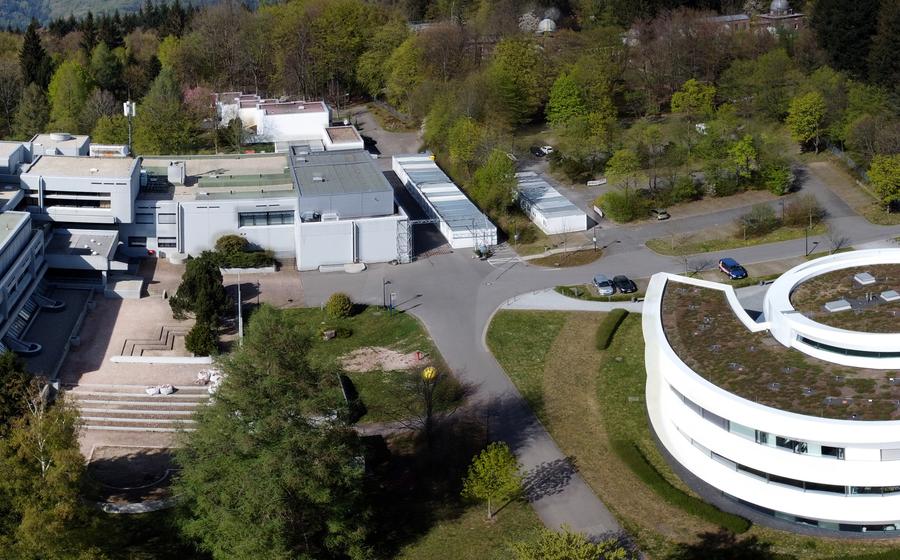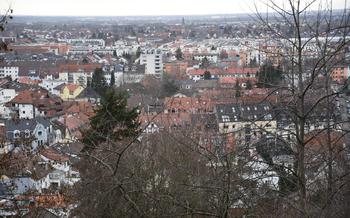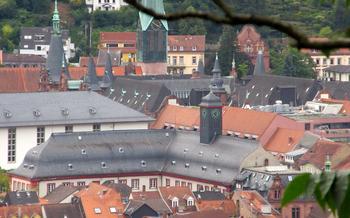
Max Planck Institute for Astronomy
- Heidelberg's Astronomical Heritage
- Max Planck Institute for Astronomy (MPIA): A Brief Overview
- Exploring the Campus
- Public Outreach and Education
- The Königstuhl Observatory: A Historical Gem
- The Large Binocular Telescope (LBT):
- Heidelberg Observatory
- Institute for Astronomical Computing (IAC):
- The Oskar Klein Center: Unveiling the Mysteries of the Universe
- Astronomical Data Center (ADC): A Gateway to Astronomical Data
- Heidelberg Center for Astronomy (HCA)
- MPIA Library: A Treasure Trove of Astronomical Knowledge
- MPIA Summer School
- Public Lectures and Events
- Insider Tip
Heidelberg's Astronomical Heritage
Heidelberg's rich astronomical heritage dates back centuries, with the city serving as a hub for groundbreaking discoveries and renowned astronomers. The most notable figure is undoubtedly Max Wolf, who revolutionized astrophotography and discovered over 800 asteroids, including the famous Trojan asteroids. Another prominent astronomer associated with Heidelberg is Karl Schwarzschild, who made significant contributions to general relativity and black hole theory. His work laid the foundation for understanding the enigmatic phenomena associated with these celestial objects. Heidelberg's astronomical legacy continues to inspire and attract researchers from around the world, eager to contribute to the ever-expanding field of astronomy.
Max Planck Institute for Astronomy (MPIA): A Brief Overview
The Max Planck Institute for Astronomy (MPIA) is a world-renowned research institution dedicated to pushing the boundaries of our understanding of the universe. Established in 1967, MPIA has a rich history of groundbreaking discoveries and has consistently been at the forefront of astronomical research.
Objectives and Research Areas:
The primary objective of MPIA is to conduct fundamental research in astronomy and astrophysics. The institute's research portfolio encompasses a wide range of topics, including:
- Cosmology: Studying the origin and evolution of the universe, including dark matter and dark energy.
- Galaxy Formation and Evolution: Investigating the formation and properties of galaxies, including our Milky Way.
- Stellar Astrophysics: Exploring the life cycles of stars, from their birth to their death.
- Planetary Systems: Searching for and characterizing exoplanets, as well as studying the formation and evolution of planetary systems.
- High-Energy Astrophysics: Investigating phenomena such as black holes, neutron stars, and active galactic nuclei.
Major Achievements:
MPIA researchers have made significant contributions to our understanding of the universe. Some of their notable achievements include:
- Discovery of Extrasolar Planets: MPIA astronomers have played a leading role in the discovery of exoplanets, using both ground-based and space-based telescopes.
- Mapping the Milky Way: MPIA researchers have conducted extensive surveys of the Milky Way, creating detailed maps of its structure and composition.
- Unveiling the Secrets of Black Holes: MPIA scientists have made significant contributions to our understanding of black holes, including their formation, properties, and interactions with their surroundings.
- Exploring the Early Universe: MPIA researchers have been involved in major projects to study the early universe, including the cosmic microwave background radiation and the formation of the first galaxies.
Exploring the Campus
The Max Planck Institute for Astronomy campus is a harmonious blend of modern architecture and historical charm. Visitors can wander through the leafy green spaces, admiring the striking buildings designed by renowned architects. The main building, known as the "Schwarzes Haus" (Black House), is a particularly iconic structure with its distinctive black facade.
The campus is equipped with state-of-the-art facilities, including several telescopes and observatories. The 2-meter telescope, located on the Königstuhl mountain, is one of the largest optical telescopes in Germany and is used for a wide range of astronomical observations. The Karl Schwarzschild Telescope, named after the famous German astronomer, is another notable instrument on campus. This 1-meter telescope is dedicated to studying the properties of stars and galaxies.
The MPIA campus also houses a visitor center, where visitors can learn more about the institute's research and history. Guided tours are available, allowing visitors to explore the facilities and gain insights into the exciting world of astronomy.
Public Outreach and Education
The Max Planck Institute for Astronomy (MPIA) is committed to public outreach and education, aiming to share the wonders of astronomy with people of all ages and backgrounds. To this end, the institute offers a range of programs and initiatives designed to engage and inspire the public.
One of the highlights of the MPIA's public outreach efforts is the visitor center, located on the institute's campus. The visitor center features interactive exhibits, hands-on activities, and stunning visuals that bring the cosmos to life. Visitors can learn about the history of astronomy, explore the latest discoveries, and even get a glimpse of the night sky through telescopes.
Guided tours of the MPIA campus are also available, providing visitors with an up-close look at the institute's research facilities and telescopes. These tours offer a unique opportunity to learn about the cutting-edge research being conducted at the MPIA and to interact with the scientists who are pushing the boundaries of our understanding of the universe.
The Königstuhl Observatory: A Historical Gem
The Königstuhl Observatory, perched atop the Königstuhl hill overlooking Heidelberg, holds a prominent place in the history of astronomy. Founded in 1890, it played a pivotal role in the development of astrophysics and contributed significantly to our understanding of the cosmos.
The observatory, with its exceptional location and clear skies, became a hub for astronomical research and observations. Astronomers like Max Wolf and Karl Schwarzschild conducted groundbreaking work here, pushing the boundaries of knowledge in their respective fields. Wolf discovered numerous comets and asteroids, revolutionizing our understanding of the Solar System's composition. Schwarzschild, known for his pioneering work on general relativity and black holes, made significant contributions to theoretical astrophysics.
Today, the Königstuhl Observatory houses the largest telescope in Germany, the 2-meter reflector telescope. This state-of-the-art instrument allows astronomers to probe the depths of the universe, studying distant galaxies, quasars, and other celestial objects. Visitors to the observatory can marvel at this impressive telescope and gain insights into the fascinating world of astronomy.
The Large Binocular Telescope (LBT):
The Large Binocular Telescope (LBT) is a unique astronomical instrument located on Mount Graham in Arizona, United States. It consists of two 4-meter primary mirrors mounted on a single mount, effectively creating a telescope with a 28-meter aperture. This innovative design allows the LBT to achieve unprecedented resolution and light-gathering capabilities, making it one of the most powerful optical telescopes in the world.
The LBT is a joint project between the University of Arizona, the Max Planck Institute for Astronomy, the Italian National Institute for Astrophysics, and the Arcetri Astrophysical Observatory. It became operational in 2007 and has since been used to make groundbreaking observations in various areas of astronomy, including the study of exoplanets, the formation and evolution of galaxies, and the nature of dark matter and dark energy.
One of the key advantages of the LBT is its ability to combine the light from its two mirrors to create a single, coherent image. This technique, known as interferometry, allows astronomers to achieve a resolution comparable to that of a 28-meter telescope, resolving fine details and structures that are invisible to smaller telescopes.
The LBT has been used to make significant discoveries, including the detection of the most distant galaxies known to date, the study of the atmospheres of exoplanets, and the investigation of the properties of black holes and quasars. It has also played a crucial role in the search for Earth-like planets orbiting nearby stars.
Overall, the LBT represents a remarkable achievement in astronomical engineering and has significantly contributed to our understanding of the universe. It continues to be a valuable tool for astronomers worldwide, enabling them to push the boundaries of our knowledge and explore the cosmos in unprecedented detail.
Heidelberg Observatory
The Heidelberg Observatory, established in 1774, holds a significant place in the history of astronomy in Germany. Located on the Königstuhl hill, it played a crucial role in the development of astronomy and served as a training ground for numerous renowned astronomers.
In its early years, the observatory focused on positional astronomy, measuring the positions of stars and planets. It made significant contributions to the astronomical catalog, a compilation of celestial objects and their positions. The observatory also played a key role in mapping the zodiacal constellations.
In the 19th century, the observatory shifted its focus to astrophysics, studying the physical properties of celestial objects. It was during this time that Max Wolf, a prominent astronomer associated with the Heidelberg Observatory, made significant discoveries in astrophotography. He captured thousands of photographs of the night sky, leading to the detection of hundreds of asteroids and nebulae.
The Heidelberg Observatory remained a prominent research institution until the mid-20th century when it faced challenges due to light pollution from the growing city. Consequently, most of the observational activities were moved to the Königsstuhl Observatory, a darker and more remote location.
Today, the Heidelberg Observatory serves primarily as a historical site and a museum, preserving the legacy of astronomy in Heidelberg. Visitors can explore the observatory's historic telescopes, learn about its contributions to astronomy, and gain insights into the lives and work of the astronomers who worked there.
Institute for Astronomical Computing (IAC):
The Institute for Astronomical Computing (IAC) at the Max Planck Institute for Astronomy is a leading center for research in theoretical astrophysics and numerical simulations. It focuses on developing and applying advanced computational methods to solve complex problems in astronomy and astrophysics.
The IAC collaborates extensively with other research groups within the MPIA and beyond. It has played a significant role in the development of software tools and algorithms that are widely used by astronomers worldwide. These tools enable researchers to analyze and interpret large datasets, simulate astrophysical phenomena, and model the behavior of stars, galaxies, and the universe as a whole.
Key research areas at the IAC include:
-
Stellar Astrophysics: Studying the structure, evolution, and dynamics of stars, including binary and multiple star systems.
-
Galactic Dynamics: Investigating the formation and evolution of galaxies, including the Milky Way, and the dynamics of stars within galaxies.
-
Cosmology: Exploring the origin and evolution of the universe, including the formation of large-scale structures and the properties of dark matter and dark energy.
The IAC's contributions to astronomy have been recognized through numerous awards and honors. Its researchers have published extensively in leading scientific journals and have made significant contributions to our understanding of the universe.
The Oskar Klein Center: Unveiling the Mysteries of the Universe
The Oskar Klein Center, nestled within the premises of the Max Planck Institute for Astronomy, exemplifies an innovative approach to astronomical research. Named after the renowned Swedish physicist Oskar Klein, the center fosters interdisciplinary collaboration, bridging the gap between astronomy, particle physics, and cosmology.
At the Oskar Klein Center, researchers delve into the profound mysteries of the universe, exploring the fundamental questions that have captivated humankind for millennia. Their investigations encompass the nature of dark matter and dark energy, the origin and evolution of galaxies, and the intricacies of black holes and gravitational waves.
The center's vibrant intellectual atmosphere attracts scientists from diverse backgrounds, creating a synergistic environment where ideas converge and groundbreaking discoveries are made. Through its cutting-edge research, the Oskar Klein Center continues to push the boundaries of our understanding of the cosmos, unraveling the secrets that lie hidden within the vast expanse of the universe.
Astronomical Data Center (ADC): A Gateway to Astronomical Data
The Astronomical Data Center (ADC), established in 1990, is a crucial component of the MPIA, renowned for its expertise in data management and dissemination within the astronomical community. The ADC serves as a central hub for collecting, archiving, and distributing a vast repository of astronomical data, enabling researchers worldwide to access and utilize this invaluable information for their studies.
At the ADC, astronomers can delve into a treasure trove of data, including observations from telescopes, simulations, and theoretical models. The center's extensive archives encompass various types of data, ranging from images and spectra to catalogs and time-series measurements. By providing these resources in a standardized and accessible format, the ADC facilitates efficient data sharing and collaboration among researchers, fostering scientific progress and innovation.
The ADC's mission extends beyond data curation and distribution. It actively engages in developing cutting-edge data analysis tools and techniques to empower astronomers in their research endeavors. These tools enable researchers to extract meaningful insights from complex and voluminous datasets, leading to groundbreaking discoveries.
Researchers can seamlessly access the ADC's resources through its user-friendly online platform. The platform offers a comprehensive search engine, allowing users to locate specific datasets of interest. Additionally, the ADC provides comprehensive documentation and tutorials to guide users in navigating the data and utilizing the available tools effectively.
The ADC's contributions have significantly impacted the field of astronomy. By providing open access to astronomical data and fostering a collaborative research environment, the center has played a pivotal role in advancing our understanding of the cosmos.
Heidelberg Center for Astronomy (HCA)
The Heidelberg Center for Astronomy (HCA) represents a collaborative alliance between the Max Planck Institute for Astronomy (MPIA) and Heidelberg University, fostering a vibrant environment for astronomical research and education. This unique partnership combines the expertise and resources of both institutions, enabling cross-disciplinary collaborations, joint research projects, and a comprehensive curriculum in astronomy.
The HCA provides a platform for astronomers, students, and researchers from diverse backgrounds to come together, share knowledge, and pursue cutting-edge research. By leveraging the complementary strengths of MPIA and Heidelberg University, the HCA offers a stimulating intellectual atmosphere that encourages innovation and discovery within the field of astronomy.
One of the key advantages of the HCA is its ability to offer a comprehensive range of courses and research opportunities to students pursuing a career in astronomy. The HCA's curriculum encompasses both theoretical and observational aspects of astronomy, allowing students to gain a thorough understanding of the subject. Additionally, the HCA provides students with access to state-of-the-art research facilities and the opportunity to work alongside leading experts in the field, fostering a hands-on learning experience.
Through the HCA, researchers have access to a wealth of resources and expertise, enabling them to tackle complex astronomical challenges and contribute to the advancement of the field. Joint research projects, workshops, and seminars foster a collaborative environment where ideas are shared, and new insights are generated.
The HCA's impact extends beyond the academic realm, as it actively engages with the broader community through outreach initiatives and public lectures. By sharing the excitement of astronomical discoveries and fostering an understanding of the cosmos, the HCA inspires the next generation of astronomers and ignites a passion for the wonders of the universe.
MPIA Library: A Treasure Trove of Astronomical Knowledge
The Max Planck Institute for Astronomy (MPIA) boasts an impressive library that serves as a valuable resource for researchers and students in the field of astronomy. Established in 1968, the library houses an extensive collection of books, journals, and other publications related to astronomy and astrophysics. With over 50,000 volumes and access to more than 300 scientific journals, the MPIA library offers a wealth of information for those seeking to delve into the mysteries of the universe. The library also provides access to a wide range of online databases, allowing researchers to stay up-to-date with the latest developments in astronomy. The MPIA library is not only a place of research but also a hub for collaboration and knowledge sharing. Researchers from around the world visit the library to access its resources and engage in discussions with fellow astronomers. The library's friendly and knowledgeable staff is always ready to assist visitors and provide guidance in finding the information they need. Whether you are a seasoned astronomer or just starting your journey into the cosmos, the MPIA library is an invaluable resource that will enrich your understanding of the universe.
MPIA Summer School
The Max Planck Institute for Astronomy offers an international summer school program that attracts students and researchers from around the world. The summer school provides an immersive learning experience in various areas of astronomy, including astrophysics, cosmology, and instrumentation. Participants have the opportunity to attend lectures and workshops delivered by leading experts in their respective fields. The program also includes hands-on activities, such as observing sessions and data analysis projects, which allow participants to gain practical experience in astronomical research. The MPIA Summer School is an excellent opportunity for students to deepen their knowledge in astronomy, establish connections with researchers in the field, and explore potential career paths in astronomy and related disciplines.
Public Lectures and Events
The Max Planck Institute for Astronomy offers a variety of public lectures, workshops, and events throughout the year, providing an excellent opportunity for astronomy enthusiasts to engage with scientists and learn about the latest advancements in the field. These events are typically free and open to the public, and they cover a wide range of topics, from the history of astronomy to the latest discoveries in cosmology.
One of the highlights of the MPIA's public outreach program is the annual Astronomy on Tap event, which takes place at a local pub in Heidelberg. This informal gathering brings together astronomers and members of the public for a relaxed evening of discussions, presentations, and Q&A sessions. The topics covered at Astronomy on Tap are diverse, ranging from black holes to the search for extraterrestrial life, and the atmosphere is always lively and engaging.
In addition to Astronomy on Tap, the MPIA also hosts regular public lectures by visiting scientists and members of its own research staff. These lectures cover a wide range of topics, from the latest results from the Large Binocular Telescope to the search for dark matter. The lectures are typically held in the MPIA's auditorium and are open to the public.
The MPIA also offers a variety of workshops and events for students and teachers. These events are designed to introduce students to astronomy and to provide them with hands-on experience with telescopes and other astronomical equipment. The MPIA also collaborates with local schools and universities to offer outreach programs and educational materials.
Overall, the Max Planck Institute for Astronomy is committed to engaging with the public and promoting astronomy education. Through its public lectures, workshops, and events, the MPIA provides an excellent opportunity for people of all ages to learn about the latest discoveries in astronomy and to interact with scientists who are pushing the boundaries of our knowledge of the universe.
Insider Tip
For an unforgettable stargazing experience, plan your visit to the MPIA during the summer months, particularly in August or September. The clear skies and warm temperatures create ideal conditions for observing the cosmos. Take advantage of the public observing nights organized by the institute, where you can peer through telescopes and learn about the wonders of the universe from expert astronomers. Remember to bring a blanket or chair to relax on the observatory grounds and enjoy the breathtaking views of the night sky.









